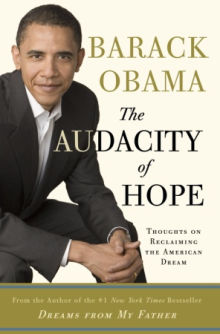Could Pre-1967 miscegenation laws be driving the present-day birther movement?
Race in America is still a hot-button issue, even having an African American president. Could the presumed birth illegitimacy of mixed-race children born before 1967 be the underlying principle that fired up the "birther movement" against President Barack Obama.
Jim Crow had a big problem with mixed-race births, but especially with mixed-race births involving white women.
Ann Dunham
Mother of Barack ObamaA Singular Woman: The Untold Story of Barack Obama's Mother Barack Obama, Sr. (left) |
 |
Barack Obama: The Audacity of Hope |
Did President Lyndon Johnson know when he signed the Civil Rights Act of 1964 that this law would stir up old prejudices that many Americans thought had outlived their usefulness?
During the Civil Rights Movement, I was growing up in Texas, the segregated home state of President Lyndon Johnson, where many Texans and others around the nation still thought Johnson to be a segregationist riding on the coattails of the assassinated President John F. Kennedy. In fact, Johnson became the civil rights president, even ascribing to its theme, "We Shall Overcome," in his hopeful message to nation frightened by his new civil rights laws.
The southern United States and much of the rest of the country still had race problems in the 1960s. But in the southern states, the race problem was amplified in cases of mixed-race children if the mother was the white parent, which signified a certain disloyalty to her race.
When President Johnson signed the civil rights legislation, no one was thinking about mixed-race African American children. After all, in those days mixed-race children were considered to be the race of whatever drop of blood they had that was not "white." Their racial categorization was not calculated by amount of "white" blood they had or how white they appeared to be. Racial categorization was calculated by whether it was known that they had non-white blood.
In those days, miscegenation laws prevented mixed-race children's parents to marry legally in many states, so their offspring were products of miscegenation and categorized further as legitimate. These bi-racial, illegitimate children of couples committing miscegenation were considered unequal under the law and subject to the same disadvantages of other black children, regardless of the legitimacy of their parents' unions.
When President Lyndon Johnson signed the Civil Rights Act of 1964, he and few others had any idea that in 1961 a mixed-race toddler, born to a white mother and a black father, would become a U.S. President and spark a birther movement.
Birther Movement? Really?
Questioning the authenticity of the president's birth records, could birthers be adhering to antiquated Jim Crow miscegenation laws to use the president's biracial heritage in an attempt to de-legitimize his human rights, U.S. citizenship legal right to hold the office of president?
Could the presumed birth illegitimacy of mixed-race children born before 1967 be the underlying principle that fires the "birther movement" against President Barack Obama?
In 1961, the year Barack Obama was born, Robert F. Kennedy predicted that the United States would elect a black president in some forty years, which happened forty-seven years later. However, Kennedy could not have predicted the birther movement that surrounded the candidacy of the nations first African American president.
In 1961, then Robert F. Kennedy, U.S. Attorney General, predicted that the United States would elect a black president in some forty years.
In 1963, when Barack Obama was two years old, President John F. Kennedy, though reluctant for political reasons to enter the civil rights struggle, finally made his declaration on civil rights. The Civil Rights Movement, however, did not categorize African Americans by percentage of racial heritage. At the time, any person with a drop of African blood were considered a "Negro."
"The Negro baby born in America today, regardless of the section of the nation in which he is born, has about one half as much chance of completing high school as a white baby born in the same place on the same day, one third as much chance of completing college, one third as much chance of becoming a professional man, twice as much chance of becoming unemployed, about one seventh as much chance of earning $10,000 a year or more, a life expectancy which is seven years shorter, and the prospects of earning only half as much." (By today's standards $10,000 in 1964 calculates to more than $75,000 today, according to Dollar Times.)
 |
| Dr. Martin Luther King, Jr., Witnesses President Lyndon Johnson Sign the Civil Rights Act of 1964 |
President Johnson may not have known at the time of the signing of the Civil Rights Act of 1964, but he must have known he was making it possible for the United States to elect a black president some day. But could he have imagined how vigorursly birthers would challenge the legitimacy?
In 1967, when Barack Obama was eight years old, the U.S. Supreme Court struck down Jim Crow miscegenation laws in Loving v the Commonwealth of Virginia. Before 1967, Obama's parents would have been breaking Jim Crow miscegenation laws had they married and lived as a family in many states in in the U.S. Although some interracial couples dealt with the struggle by moving to states that allowed interracial marriage, while others were not able to do so. And their children were not able to escape the birth stigma of being considered illegitimate. Because Jim Crow laws prevented legal marriage and attempted to prevent intimate relationships between people of different races, many interracial couples residing in certain parts of America faced great difficulty living as the legal unit, known as a family.
 |
| The Loving Story |
Mixed-race children of Richard and Mildred Loving were automatically labeled by the government and treated accordingly.
 |
| Richard Loving and Loving Children |
Ironically, a mixed-race person was barred by Jim Crow laws from marrying a person the same race as a parent, if one parent happened to be classified as black, no matter how light their skin.
 |
| Mississippi Delta Chinese Farm Laborers |
Jim Crow laws against miscegenation also applied to other races, including the Chinese.
 |
| Italian Farm Workers |
The Chinese, subjected to some of the worse discrimination and violence in American history, were "colored" to the law and treated accordingly. After coming to America during the Gold Rush and being denied claims, then building railroads across the nation and then being burned out of their homes after their labor was no longer needed, they were shipped off to the Mississippi Delta under indentured farm labor agreements with former plantation owners.
Light or dark, Chinese, Mexicans, Native Americans, former slaves, Italian immigrants and all the rest, who found themselves in rural regions were usually relegated to sharecropping arrangements, low-paying farm work, preaching, teaching, barbering and such, living in inferior housing resembling the slave quarters they had left only recently. Those migrating to the cities could expect to be relegated to similar low-end jobs and inferior ghetto housing.
In the event skin color, hair texture and facial features did not reveal their racial makeup, direct testimony of their racial makeup, as in the one-drop theory, would certainly destroy their passing as white. In fact, white families were destroyed or driven from communities by slanderous neighbors of the possibility of African blood in their genetic line. Sometimes this happened if a white family was too sympathetic to a black or immigrant family or tried to help a black person or immigrant in trouble.
Race in America is still a hot-button issue, even having an African American president. Could the presumed birth illegitimacy of mixed-race children born before 1967 be the underlying principle that fires the "birther movement" against President Barack Obama?
Bigmama Didn’t Shop
At Woolworth’s
Sunny Nash
Hard Cover
Amazon Kindle
|
 |
| Sunny Nash |
Sunny Nash’s book is recognized by the Association of American University Presses as essential for understanding U.S. race relations.
Nash's book is also listed in the Bibliographic Guide for black studies at the Schomburg Center for Research in Black Culture in New York; and recommended for Native American collections by the Miami-Dade Public Library System in Florida. Nash uses her book to write articles and blogs on race relations in America through topics relating to her life--from music, film, early radio and television, entertainment, social media, Internet technology, publishing, journalism, sports, education, employment, the military, fashion, performing arts, literature, women's issues, adolescence and childhood, equal rights, social and political movements--past and present—to today's post-racism.
© 2014 Sunny Nash. All Rights Reserved Worldwide.

Custom Search
Also please take a moment to share your thoughts on the comment form below.
Let people know how you feel. Tweet





No comments:
Post a Comment
Note: Only a member of this blog may post a comment.